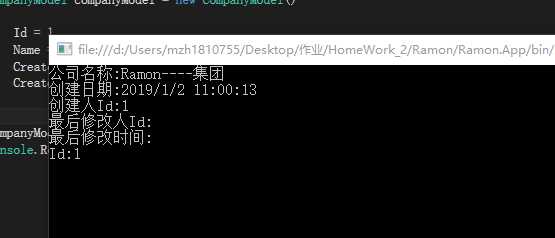C# 自定义特性Attribute
2021-01-23 23:13
标签:oid sum this att 自定义 程序代码 构造 eth ring 一、特性Attribute和注释有什么区别 特性Attribute A:就是一个类,直接继承/间接继承Attribute B:特性可以在后期反射中处理,特性本身是没有什么*用的 C:特性会影响编译和运行时功能 注释 A:就是对代码的解释和说明,其目的是让人们能够更加轻松地了解代码。注释是编写程序时,写程序的人给一个语句、程序段、函数等的解释或提示,能提高程序代码的可读性 B:注释不能后期处理 二、自定义Attribute特性的使用 自定义Attribute特性的语法 其实特性就是一个类,直接继承或者间接的继承Atrribute的就是一个特性 首先声明特性,以下面的代码举个例子 特性的使用 首先我们准备一个自定义特性DisplayName 自定义特性 在CompanyModel的属性上使用DisplayName的特性 BaseModel CompanyModel 我们标识了这些特性到底要怎么使用呢? 文章的开始就已经说了特性可以在后期反射中处理,特性本身是没有什么*用的 那么我们通过反射如何去使用特性 接下来以上面给出的代码去实现,定义了一个扩展方法 用到了反射和泛型等知识,如果有小伙伴不懂可参考以下文章 代码调用 结果 二:特性的运用范围 特性运用范围极其广,框架中我们看到上面的总结就晓得了,下面的我总结了以下几个地方也可以使用特性 1:数据展示 不想展示属性名字,而是用中文描述 然后特性还可以校验一些数据字段等,下面我写个例子,以便更加容易理解: 1:先创建数据校验的特性 2:再一个实体类上面的字段增加特性 3:写下面的方法,使特性生效 4:应用判断时如下: 这样就完成了数据校验,特性校验的特点,总结得到了如下三点: 1:可以校验多个属性 运用了这个特性校验后,就不用再每个地方再分别写校验的逻辑,简单易用! C# 自定义特性Attribute 标签:oid sum this att 自定义 程序代码 构造 eth ring 原文地址:https://www.cnblogs.com/IT-Ramon/p/12061034.html
//直接继承Attribute
public class CustomAttribute : Attribute
{
public string Name { get; set; }
public CustomAttribute()
{
Console.WriteLine($"{this.GetType().Name} 无参构造函数");
}
public CustomAttribute(string name)
{
Console.WriteLine($"{this.GetType().Name} string 参数构造函数");
Name = name;
}
}
//间接继承Attribute
public class CustomAttributeChild : CustomAttribute
{
public CustomAttributeChild()
{
Console.WriteLine($"{this.GetType().Name} 无参构造函数");
}
public CustomAttributeChild(string name) : base(name)
{
Console.WriteLine($"{this.GetType().Name} string 参数构造函数");
}
}


///

namespace Ramon.Common.Framework
{
public class BaseModel
{
public int Id { get; set; }
}
}
namespace Ramon.Model.Model
{
public class CompanyModel : BaseModel
{
[DisplayName("公司名称")]
public string Name { get; set; }
[DisplayName("创建日期")]
public DateTime CreateTime { get; set; }
[DisplayName("创建人Id")]
public int CreatorId { get; set; }
[DisplayName("最后修改人Id")]
public int? LastModifierId { get; set; }
[DisplayName("最后修改时间")]
public DateTime? LastModifyTime { get; set; }
}
}
反射:https://www.cnblogs.com/Ramon-Zeng/p/10189097.html
泛型:https://www.cnblogs.com/Ramon-Zeng/p/10172818.html
public static class BaseModelExtenstion
{
public static void ConsoleEntity


class Program
{
static void Main(string[] args)
{
CompanyModel companyModel = new CompanyModel()
{
Id = 1,
Name = "Ramon----集团",
CreateTime = DateTime.Now,
CreatorId = 1,
};
companyModel.ConsoleEntity();
}
}


2:想指定哪个是主键,哪个是自增
3:别名 数据库里面叫A 程序是B,怎么映射等public abstract class AbstractValidateAttribute : Attribute
{
public abstract bool Validate(object oValue);
}
public class LongValidateAttribute : AbstractValidateAttribute
{
private long _lMin = 0;
private long _lMax = 0;
public LongValidateAttribute(long lMin, long lMax)
{
this._lMin = lMin;
this._lMax = lMax;
}
public override bool Validate(object oValue)
{
return this._lMin long)oValue && (long)oValue this._lMax;
}
}
public class RequirdValidateAttribute : AbstractValidateAttribute
{
public override bool Validate(object oValue)
{
return oValue != null;
}
}
public class Student
{
[RequirdValidate]
public int Id { get; set; }
[LongValidate(5,10)]//还有各种检查
public string Name { get; set; }
[LongValidate(20, 50)]
public string Accont { get; set; }
///
public class DataValidate
{
public static bool Validate
Student student = new Student();
student.Id = 123;
student.Name = "MrSorry";
student.QQ = 123456;
var result = DataValidate.Validate(student);
2:可以支持多重校验
3:支持规则的随意扩展